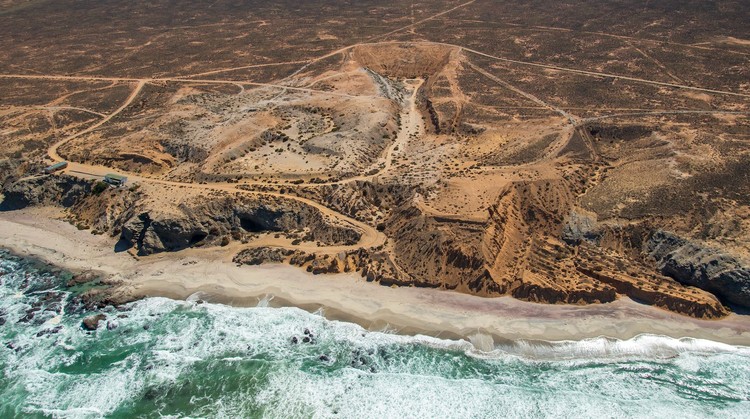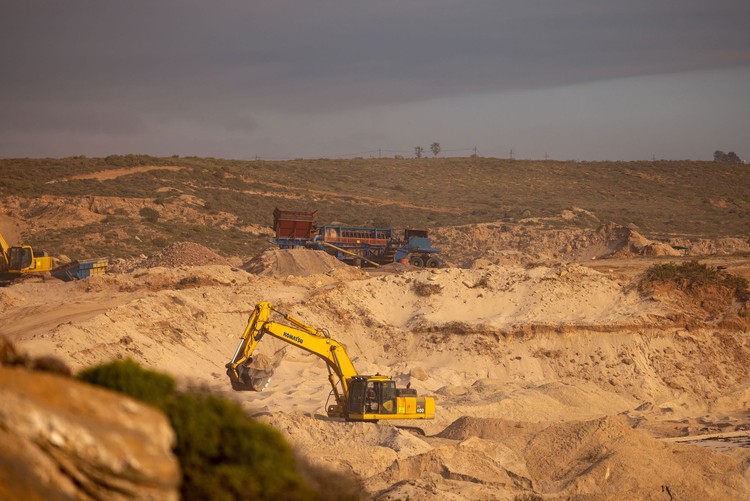Court challenge to 30-year extension of West Coast diamond mining rights
Fishers say they were ignored when the original rights were awarded between 1994 and 1998
Damage to the West Coast north of the Olifants River estuary caused by previous diamond mining operations (before Trans Hex). Photo: John Yeld
- Ten diamond mining rights on the West Coast, originally awarded between 1994 and 1998, have been extended by 30 years.
- Environmentalists and fishers are challenging the extensions in court, arguing that the basis on which the rights were granted is long outdated and new assessment and public consultations are required.
- The Trans Hex mining group say the challenge to the renewals of the rights is baseless, and wrong in law and in fact.
- The first part of the matter will be heard in the Western Cape High Court on Tuesday.
Legal action that could profoundly impact the future regulation of mining in South Africa, in particular environmental approvals and public participation, is scheduled to start in the Western Cape High Court this week.
On Tuesday, the first part of an application will be heard challenging the awarding of 30-year extensions to ten diamond mining rights on the West Coast held by the Trans Hex group.
The applicants are environmental non-profit organisation Protect the West Coast, two groups of small-scale fishers from Doringbaai and the Olifants River estuary, and two individual fishers from Doringbaai.
They argue they were not informed about, nor given an opportunity to comment on, these lengthy mining rights extensions. They were also ignored when the original rights were awarded between 1994 and 1998.
They argue the environmental management programmes (EMPs) on which these mining rights are based are more than 20 years old and hopelessly outdated. They argue new authorisations are required in terms of the National Environmental Management Act (NEMA) and other legislation that came into effect after the original rights were granted.
The application is being opposed by Trans Hex Operations (Pty) Ltd.
The respondents are the national mining minister (currently Gwede Mantashe); regional manager of the Department of Mineral Resources and Energy (DMRE); Moonstone Diamond Marketing (as Trans Hex Operations was still named when the application was filed); national environment minister (currently Barbara Creecy); the Western Cape provincial MECs for transport and public works, and the environment; and the Matzikama local municipality.
Mining operations
Trans Hex Operations – called Moonstone Diamond Marketing (Pty) Ltd between February 2020 and February this year – currently holds ten mining rights along an 85km stretch of the West Coast, between Lamberts Bay and Sout River to the north.
These rights, granted between 1994 and 1998, were so-called “old order” mining authorisations issued under the Minerals Act of 1991. This act was replaced by the Mineral Petroleum Resources Development Act of 2002 (MPRD) and the authorisations converted to mining rights.
Three of the ten areas are for mining in the shallow sea, from about 32 metres to about a kilometre offshore.
The other seven are associated rights in the coastal strip, extending from the edge of farm boundaries to about 32 metres offshore, including the beach and surf zone.
Two project-specific EMPs covering the ten mining concession areas were approved and published in October 2002, and revised and updated (but not formally approved) in 2005, without any public consultation.
In 2015, the DMRE extended the existing mining right in one of Trans Hex’s three sea concessions for 30 years, and in October 2021 extended the mining rights in all its other nine areas, also for 30 years. There was no public participation in, or announcement of, these awards.
Although in 2021 the DMRE directed the mining company to update the two 2002 environmental management programmes that regulated their activities in the three sea concession areas and related surf and beach zones, no deadlines were imposed for such an update and no restrictions on mining in the meantime were applied.
Court challenge
After failing to get crucial information about the rights extensions from the DMRE, including through a Promotion of Access to Information (PAIA) application, the applicants launched urgent court action on 18 December 2022.
Their application is in two parts. Part A, being heard on Tuesday, is for an interdict to halt any mining activities by Trans Hex and its contractors in the sea concession areas where rights were renewed, pending the resolution of Part B of the application which challenges the legitimacy of those rights.
Part B consists of three applications: for a final interdict to stop all mining in the sea concessions until Trans Hex is granted Environmental Authorisations under NEMA; for the court to review and set aside the original decisions to grant mining rights in the three sea concessions; and to review and set aside the most recent decisions to renew these mining rights and all previous renewals.
In his founding affidavit, Mike Schlebach, director of the Protect the West Coast (the first applicant), argues there have been “significant and material” changes in the legal framework governing mining and the environmental impact of mining since the advent of democracy.
The environmental obligations for the mining are based on “outdated and wholly inadequate” EMPs dating back to 2002, states Schlebach.
The applicant’s challenge is also based on the claim that there was no public consultation before the extensions to the mining rights were granted. It happened “unbeknownst to the public and behind closed doors”.
“Given that South Africa is now a world leader in coastal zone assessment, it is unacceptable that renewals of mining rights were approved in 2021 for an 85km stretch of coast – scientifically acknowledged to be a national mining-conservation hotspot – based on an outdated EMP from 2005 lacking critical information for sound decision-making when new instruments are available to secure sustainable coastal development and management,” states Schlebach in his affidavit.
He points out that some of the other applicants – the fishers at Doringbaai, a small West Coast fishing village about 15km south of the Olifants River estuary – only became aware of the 30-year renewal through a local newspaper article on 12 August 2022. This was the so-called 13A sea concession.
Others in the community heard about it for the first time in a meeting with the Legal Resources Centre on 26 October 2022.
“The last 17 years saw significant changes in the socio-economic conditions of Doringbaai, and it is inconceivable that mining as invasive as what is happening on the beach can commence without a contemporary understanding of its potential impacts on the host community.
“The same can be said of the Olifants River Estuary and the impact that mining will have on the livelihoods of the Olifants River fishers who fish there,” states Schlebach.
Trans Hex responds
In an answering affidavit, Trans Hex operations director Ian Hestermann states the group has been engaged in the exploration, mining and marketing of West Coast diamonds for almost 60 years.
Arguing that Part B of the application has “no prospects of success”, he states the applicants “raise a number of unsubstantiated allegations”, and that the company’s operations in terms of its mining and prospecting rights and the 2002 EMP are lawful.
“Trans Hex has and maintains an impeccable record of environmental compliance and has taken seriously the obligations to comply with its EMPs and to undertake rehabilitation wherever necessary… The applicants’ challenge to the original grant of the mining rights is unsubstantiated and baseless and their challenge to the renewals of those rights is wrong in law and in fact,” states Hesterman.
Although both applicants and Trans Hex have filed voluminous papers setting out their respective arguments in respect of Part B of the application, Tuesday’s hearing will only relate to the interim interdict application of Part A.
One of the crucial legal requirements for obtaining an interdict is reasonable apprehension of irreparable harm if it is not granted.
Schlebach argues that “reliance on the 2005 EMP as the management tool for the current mining operations is unlawful and presents a grave threat of irreparable harm. Significant and material environmental impacts have simply not been assessed at all, and where they have been, the information and assessment tools are dated. There are therefore major limitations on the present knowledge of the impact and consequences of the mining on the environment”.
“Once this coastline area and the Olifants River estuary have been damaged or destroyed, they are lost not only for present but also future generations.”
But Hestermann countered that the applicants offer “only speculative, broad and generalised contentions about the environmental nature of the concession areas”.
In negotiations leading up to Tuesday’s hearing, the mining company gave several undertakings which, it argues, “render the allegations of harm redundant”.
These include that beach mining operations between the high-water and low-water marks at Doringbaai will not recommence until both Part A and Part B of the application have been finalised; all beach mining operations will be confined to its Bethel and Weskus mining rights and it will not increase the size of these operations; it will not conduct any mining operations of any type within a significant area surrounding the Olifants River Estuary – the so-called “Olifants River Estuary no-go zone”; and it will not undertake any land-based mining operations in several conservation worthy areas along the West Coast adjacent to its three sea concession areas.
Trans Hex mining the beaches for diamons near Doringbaai on the West Coast in September last year. This particular operation has since been stopped. Photo: Sacha Specker/Protect the West Coast
Support independent journalism
Donate using Payfast

Don't miss out on the latest news
We respect your privacy, and promise we won't spam you.
Next: Streets in Durban township are covered in sewage
Previous: Taxi strike cost Western Cape R5-billion, MEC tells Parliament
© 2023 GroundUp. This article is licensed under a Creative Commons Attribution-NoDerivatives 4.0 International License.
You may republish this article, so long as you credit the authors and GroundUp, and do not change the text. Please include a link back to the original article.
We put an invisible pixel in the article so that we can count traffic to republishers. All analytics tools are solely on our servers. We do not give our logs to any third party. Logs are deleted after two weeks. We do not use any IP address identifying information except to count regional traffic. We are solely interested in counting hits, not tracking users. If you republish, please do not delete the invisible pixel.


